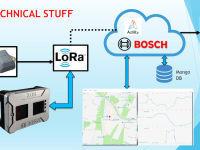Brief: Tackling water pollution using IoT
The problem which i want to tackle is of water pollution. Presently, much of focus is placed towards treating water pollution rather than preventing it. We all know the major causes of water pollution which are discharge of untreated sewage from domestic and industrial areas along with chemical runaway from agricultural fields, yet we are not able to contain the sources.
One of the major reason for that is the lack of accurate pollution data which not only tells us about if the water is polluted or not but also tells us about the type of pollutants present in water along with precise geographical location of the water quality data.
Till date, water pollution is either checked from satellite sources or stationary sensors which may be deployed at monitoring sites. The limitation with these solutions is that they do not provide geographical information from which the source can be traced back to. (these can detect the water quality but not the source from where the pollutants are entering into the water body).
My proposed solution is a measurement probe which floats around in a water body collecting water quality data along with precise GPS location. This data can be transmitted over the internet to a cloud server, where it can be analysed and be used to generate a heat map to detect the change in level of pollution along the direction of its traversal. The movement of the floating platform shall be only dependent on the stream of the current of the water body. Since there will be no moving parts, risk of mechanical failure is minimized and design complexity is reduced drastically.
Floating principle of the sensor unit can be achieved using the buoyant effect as used in floating buoys in sea ports. Various sensors for measuring water quality can be mounted on the floating platform. For powering the sensor units and telemetry systems, a solar panel can be used with robust mounting and reinforced transparent protective covering. For establishing data communication, GSM and LoRa WAN (Low Radiation Alliance Network for IoT devices) can be used, which has range upto 10km. Due to the possibility of network not being available, the data processing unit on the floating platform can be equipped with sufficient memory, which can act as buffer until network communication is available again.
Using the data posted on cloud, we can analyse the local hotspots of pollution along with identifying the areas where there is a spike in the pollutants level indicating the probable source of water pollution.
USE CASES:
Government and municipal bodies can plan sewage treatment more efficiently.
Commercial application in Clean Ganges Project in India
Better regulation and check of industrial waste to prevent pollution
Check on runaway from agricultural fields
This data can also be useful for scientists to study the ecology of a water body much precisely and help in better research work.
Video
Like this entry?
-
About the Entrant
- Name:Mohit Kalra
- Type of entry:individual
- Patent status:none





